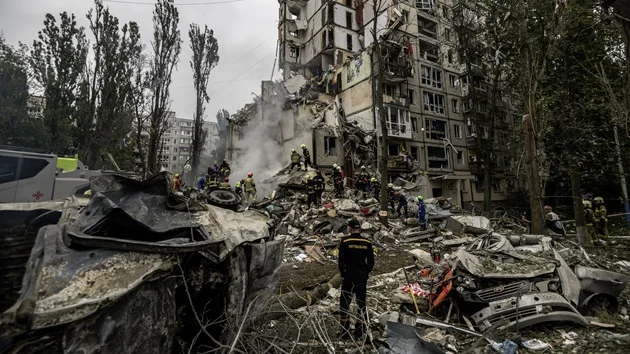(LONDON) — More than three years into Russia’s full-scale invasion, Ukrainians across the country retreat each night to bomb shelters and metro stations in a nightly ritual necessitated by the long reach of Moscow’s drones and missiles. This summer, Ukrainians are spending more time in such shelters than ever before.
The first bombardments of Kyiv and other major cities began in the early morning of Feb. 24, 2022, as Russian troops surged across Ukraine’s borders on several axes. In the years since, the attacks have never stopped.
Through July, Russia launched a record 6,443 drones and missiles into the country, according to data published by the Ukrainian air force. The total is the highest of the war to date, and around 13% more than were recorded in June.
The scale and complexity of Russia’s drone and missile barrages have steadily increased through the war. The Iranian-designed Shahed strike drone — adopted enthusiastically by the Russian military and rebranded as the Geran — has become the workhorse of Moscow’s nightly harassment of Ukrainian cities and vital infrastructure.
For many Ukrainians, the “flying mopeds,” as the Shahed and Geran variants have become known due to their distinctive sound, are emblematic of the Russian threat.
The strikes are terrorizing and deadly. June saw the highest monthly level of Ukrainian civilian casualties in more than three years, according to data published by the UN Human Rights Monitoring Mission in Ukraine — 232 people killed and 1,343 people injured.
Neither Russia nor Ukraine publish data detailing the scale of their own strike campaigns. Ukraine’s air force publishes a daily tally of Russian drone and missile strikes, while Russia’s Defense Ministry only publishes figures of Ukrainian drones shot down.
July marked a high-water mark for Russian drone attacks on Ukraine. Data published by the Ukrainian air force and analyzed by ABC News recorded a total of 6,245 attack and decoy drones launched into the country over the past month at an average rate of around 201 per day.
Russia also launched 198 missiles, with an average of more than six each day.
Though Ukraine’s interception rate is significant, plenty of projectiles arrive with devastating effect. July saw around 89% of drones and around 61% of missiles shot down or otherwise suppressed.
By comparison, June saw 5,438 drones and 239 missiles fired into Ukraine, with a daily average of 181 drones and nearly eight missiles. The air force downed or suppressed 87.2% of all drones and 73% of missiles during June.
And in May, Russia launched a total of 3,835 drones and 117 missiles, for an average of around 124 drones and nearly four missiles each day. Across the month, 85.7% of drones and 57% of missiles were shot down or suppressed.
“Right now, Ukraine sees around 300 to 400 drones attacking civilian targets every day — these types of numbers were unheard of in 2023 or 2024,” Yuriy Boyechko, the founder and CEO of the Hope for Ukraine charity, told ABC News.
Moscow shows no sign of letting up. Russian officials and media have made much of the country’s growing drone production capabilities. A recent report by the Zvezda television channel, for example, showed operations at a Geran factory in Alabuga in Russia’s Republic of Tatarstan, with workers constructing and piling up dozens of attack drones ready for delivery.
The design of the attack drones is ever-evolving. The first were light gray-colored craft flying low and relatively slow to their targets, carrying high-explosive and fragmentation payloads and powered by turbines.
More recently, Geran variants painted black with special material to hide from radar fly higher and with tortuous routes to evade Ukrainian defense teams. Some are armed with thermobaric warheads, are armored and some are powered by jet engines. Ukrainian defenders have also reported that recent Gerans are using AI targeting systems.
Russian forces may soon be able to launch 1,000 to 2,000 drones per day, according to recent warnings issued by the Institute for the Study of War think tank and German Maj. Gen. Christian Freuding.
Pasi Paroinen, an OSINT analyst at the Finland-based Black Bird Group, told ABC News he believes it feasible that Russia could soon launch 1,000 drones per night.
The drone barrages are effective and relatively affordable. Various estimates for the cost of domestically-produced Gerans range from around $10,000 to $50,000.
Though the Western sanctions campaign has complicated Russian military procurement efforts, components from Western companies are still found in their dozens in downed Gerans — a fact repeatedly highlighted by frustrated officials in Kyiv.
The mix of strike and decoy drones poses a “very nasty” problem for Ukraine’s thinly-stretched air defense, Paroinen said. “They have been doing pretty well intercepting them overall. But it’s also tying up Ukrainian manpower — they have to have those groups of mobile anti-aircraft groups rolling around the countryside, shooting these things down.”
“The general consensus among analysts is that this is going to be a major problem,” Paroinen said. “And this is a production capability that won’t be going away, even if the war ends it will still have implications for the rest of Europe as well, that Russia will be able to produce and stockpile these weapons in pretty intense numbers.”
President Donald Trump’s repeated interventions seem to also have failed to move the needle. The president has repeatedly expressed his frustration with Russian President Vladimir Putin’s continuation and expansion of drone and missile strikes on Ukraine.
Putin, Trump said earlier this month, “talks nice and then bombs everybody.”
Ukraine has used its own fast-evolving drone arsenal to target drone production facilities deep inside Russia, but to little apparent avail.
Kyiv is increasing the intensity of its drone attacks into Russia. Across July, the Defense Ministry in Moscow reported downing 3,008 Ukrainian drones at an average of around 97 per day.
In June, the ministry reported downing a total of 2,368 Ukrainian drones, with an average of almost 79 drones per day across the month. Those figures were down from May, during which the ministry said it shot down 3,611 drones with an average of 116 per day.
But, Paroinen said, there is little Ukraine can do about Russia’s growing drone production capability. “It’s far enough away from the front lines that there are not really that many weapons that can reach it. Maybe some very long-range drones, but overall, trying to destroy such a factory is beyond their means,” he said.
“To take down a big industrial complex really takes a lot more firepower and explosives than they can deliver, even if they launch hundreds of drones and have dozens of them hit the target,” he continued. “It’s not that easy — and usually the damage can be repaired pretty quickly.”
Copyright © 2025, ABC Audio. All rights reserved.

















